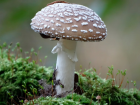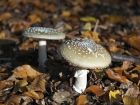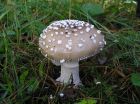Cap initially domed and later flattens out, with a very finely striated margin. It is shiny brown or grey-brown and has densely distributed warts that are pure white to sordid cream in colour. These warts are minutely verruculose and can be easily removed. Gills free, close to crowded, white becoming greyish, truncate and fairly broad. Stem subcylindrical, white, becoming slightly tannish in age, stuffed then hollow, finely floccose becoming smooth above the white ring that is initially quite chunky but often becomes thin and floppy in more mature specimens, sometimes with a toothed edge. The stem tapers towards the apex and ends in a swollen basal bulb. Spore print white.
Microscopic Features: The spores are broadly ellipsoidal to ovoid in shape, with a smooth surface. They measure 8-12 µm in length and 6.7-7.5 µm in width. They are inamyloid.
Similar species include Amanita rubescens, which also can have a brownish cap but its stem and cap flesh turn pink or red when damaged.
Amanita pantherina on the First Nature Web site.
Amanita pantherina on the MushroomExpert.Com Web site.
Many mushrooms are poisonous, and some can be lethally toxic. Distinguishing between edible and poisonous mushrooms can be very challenging. Therefore, we strongly advise against consuming wild mushrooms. This website does not contain any information about the edibility or toxicity of mushrooms.
Although efforts have been made to ensure accuracy on this website, the information may contain errors and omissions. Therefore, all content provided is for educational and informational purposes only and should not be relied upon or used as a basis for consuming any plants or mushrooms.
External links are provided for reference only. We do not endorse or take responsibility for the content, advice, or products found on these sites or in any advertisements shown on this website.


